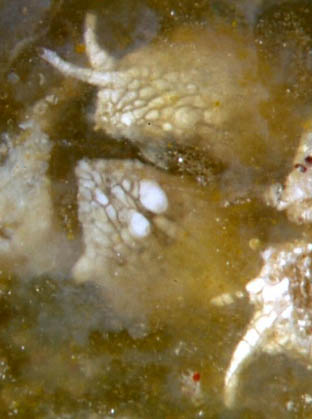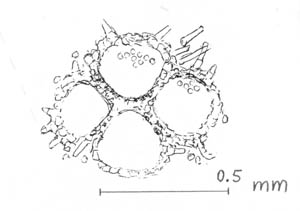Hairs on Scolecopteris
sporangia
Hairs on sporangia are a typical feature of 5 of
the 15 Scolecopteris species distinguished by
Millay
[1].
( Scolecopteris
is the name of the foliage of Palaeozoic tree ferns which are better
known under the name of their stems, Psaronius.)
Hairs are
assumed to be completely absent on the sporangia of the “maggot fern”
from Döhlen basin, Sc. elegans.
In view of
the several pieces of evidence lately accumulated which indicate the
presence of more than one Scolecopteris species at
the type locality of Sc. elegans it is not
surprising
that, among the hundreds of chert samples cut and polished in the
latter years,
hairy sporangia have been discovered in two of them (Figs.1,2).


Fig.1: Cross-section of a synangium
composed of 4 hairy sporangia; non-identified Scolecopteris
species from the type locality of Sc.
elegans,
Döhlen basin.
Fig.2 (far left): Sporangium tips with
two hairs each (cut off on one of them); non-identified
Scolecopteris species from the type locality of Sc. elegans,
Döhlen basin.
It is not obvious how to interpret these observations. The
hairs could
be an incidentally re-activated old feature inherited from hairy
ancestors but normally suppressed in Sc. elegans, or
else they could indicate the presence of other species. Anyway it is
worth while trying to relate the finds to the 5 hairy species: Sc. minor, Sc. latifolia, Sc.
mamayi, Sc. monothrix, Sc. vallumii.
The synangium cross-section in Fig.1 is compatible with Sc. minor but not
with the others: Sc.
latifolia looks quite different according to a picture in
[1], the sporangia of Sc.
mamayi have the hairs only at their tips, those
of Sc.
monothrix have only one very long hair each, and also the
hairs of Sc.
vallumii are much longer.
The sporangia with two hairs each near the tip as seen in clear
chalcedony in Fig.2 do not seem to fit onto any of the hairy species:
Pinnules with forked veins have been found near the sporangia, most
probably being related to them. This excludes Sc. mamayi, which
is said to have non-forked veins. Again, Sc. monothrix and Sc. vallumii can be
excluded because of the length of their hairs.
The observation of two types of hairy sporangia at the type locality
of Scolecopteris elegans
adds to the evidence for the presence of other
species. (See also the contribution on veining
patterns.)
Specimens: Chert from the type locality of Scolecopteris elegans,
Lower Permian, Döhlen Basin;
own collection; Fig.1:
Bu13/19.1, (1998); Fig.2: Bu7/140.2, (2003), raw
sample obtained from Gert Müller.
H.-J.
Weiss
2011
[1] M.A. Millay:
Study of paleozoic marattialeans. A monograph of the American species of Scolecopteris,
Palaeontographica B169(1979), 1-69
|
 |
 3 3 |

 3
3


 3
3